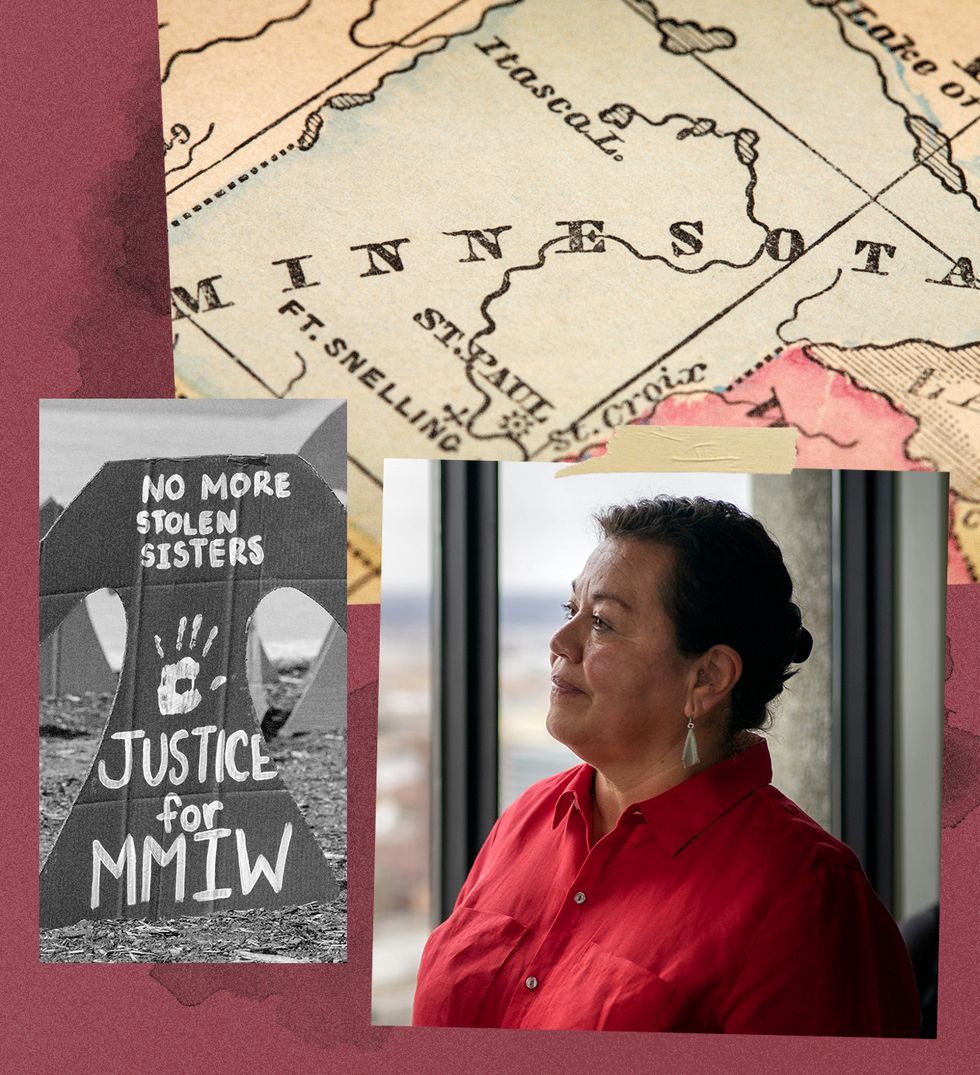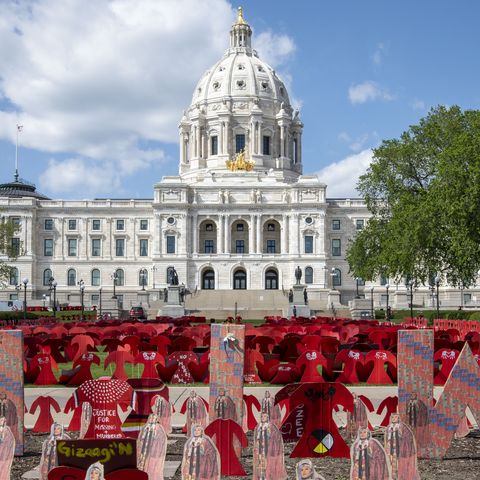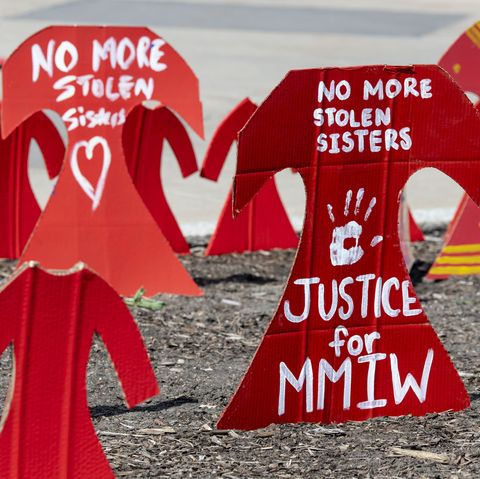Native Women and Girls Are In Crisis. In a First-of-Its-Kind Role, Juliet Rudie Is Hoping to Change That
Across America, Indigenous women, girls, and their relatives are in crisis. In the U.S., murder is the third leading cause of death for Native women, who face homicide rates up to 10 times the national average. Many have also gone missing, disappearing from their communities at alarming rates—but without a single federal agency providing reliable, comprehensive data collection, accurate statistics are hard to come by. What we do know is this: It’s an epidemic. And for Juliet Rudie, it’s personal.
Over the past two decades, the 59-year-old Lower Sioux Indian Community tribal member has lost three cousins. Two were killed—one on Minnesota’s Red Lake Nation in 2005 and another on South Dakota’s Yankton Indian Reservation in 2017—and another disappeared without a trace in 2017. There’s been no sense of closure for Rudie or her extended family; the cases remain open and unresolved to this day, an unfortunately common experience among tribal communities, who have long felt ignored by both the public and public safety officials. But now, Rudie is hoping to tackle this national problem head on as Minnesota’s new director of the Office for Missing and Murdered Indigenous Relatives—a first of its kind office in the United States.
For Rudie, this is the latest chapter in a lifetime of public service, following the example set by her dad, a former police officer, and her mom, who worked for the Minnesota Office of Indian Education. Rudie first joined the St. Paul police force in 1990, and her 28-year career in law enforcement spanned patrol, investigations, and internal affairs. In 2017, she became the first woman to be made chief deputy sheriff of Ramsey County. “I’ve got experience with barriers,” Rudie says. “I have hope because, look, there was a time when women and Native Americans couldn’t vote. It might feel like change takes a long time, but change does happen.”
That kind of long-view thinking will be essential in her new role. The statistics in Minnesota alone are staggering: Native Americans make up just one percent of the population but represent approximately nine percent of all murdered women and girls in the state. It’s data like this that’s driven the statewide bipartisan Missing and Murdered Indigenous Women Task Force’s ongoing efforts, including presenting a comprehensive report to Gov. Tim Walz back in Dec. 2020. The report cited colonialism, historic trauma, systemic racism, and sexual objectification as root causes for this crisis and, among other mandates, called for the creation of Rudie’s office, which was established last summer. Now, she hopes to bridge the divide between tribal nations and this new government agency.
Minnesota Lt. Gov. Peggy Flanagan, a member of the White Earth Band of Ojibwe, says Rudie “brings incredible leadership, nearly three decades of professional expertise in public safety, and her lived experience as a Native woman to this important work.” She also says, “Native women led the movement to call attention to this issue in the halls of power. Native women moved the legislation and got it signed by the governor. And now, a Native woman will lead the work of this office. It is as it should be.”
But that doesn’t mean the work will be easy. Some of Rudie’s first priorities include cultivating strong relationships with Minnesota’s 11 tribal nations; establishing a reporting and response protocol to ensure both Indigenous groups and law enforcement officials properly handle missing person and murder cases (which should in turn lead to more effective investigations); developing education and prevention programs that teach Native girls and women about human trafficking, sexual exploitation, and intimate partner violence; working to wrangle fractured crime data (an effort complicated by jurisdictional challenges across tribal nations and government agencies); and hiring three staffers to help her accomplish all this, as Rudie is currently an office of one. She also hopes to set up a hotline for tips and support, employ crime mapping to identify trends, and better utilize existing alert systems (think: Amber Alerts) to call for the public’s help.
Her office will also serve as a model for other states to follow, acting as a centralized resource for data collection, victims’ services, and community education. Rudie envisions a future network of offices working closely together and with other organizations to reduce—and hopefully eliminate—violence against Native Americans. Already, Utah, Washington, and Wisconsin have formed similar task forces and are taking steps to address the crisis at the state level.
Rudie is also encouraged by federal efforts, like Interior Secretary Deb Haaland’s newly formed Not Invisible Act Commission, which aims to improve the government’s approach to the crisis, including tracking and reporting data as well as developing legislative and administrative changes.
“Everyone deserves to feel safe in their communities, but the [missing and murdered Indigenous peoples] crisis is one that Native communities have faced since the dawn of colonization,” Haaland, a Pueblo of Laguna citizen and the first Native American to serve as a Cabinet secretary, said on Missing or Murdered Indigenous Persons Awareness Day this year. “For too long, this issue has been swept under the rug by our government with a lack of urgency, attention, or funding.”
It’s partly why there’s often a mistrust of law enforcement, particularly among BIPOC communities in Minnesota, where there have been at least three highly publicized police killings of Black men—George Floyd, Daunte Wright, and Amir Locke among them—in recent years. “I’ve definitely seen a lack of trust in law enforcement among Native communities, because there’s a sense that they’re not going to help,” Rudie says, acknowledging the historically complicated relationship between tribal nations and law enforcement, which has ranged from indifference to outright brutality. (Native Americans are killed in police encounters more than any other racial or ethnic group, according to data from the Centers for Disease Control and Prevention.) “I think that lack of trust comes from a lack of action, a lack of consistency, and a lack of caring,” she says. “But I’m an optimist, and I believe there’s a lot of good police work that gets done, too.”
For Native communities, that mistrust also extends to mainstream media, where outlets often perpetuate “missing white woman syndrome,” a phrase coined by the late PBS journalist Gwen Ifill to describe the disproportionate coverage of endangered white women in contrast to BIPOC women. That disparity was writ large in fall 2021, when 22-year-old Gabby Petito’s disappearance and death in Grand Teton National Park captivated international audiences, while 15-year-old Red Lake Nation member Nevaeh Kingbird’s disappearance and ongoing case received little reporting. “When a young white woman disappeared with her boyfriend, everybody in the world wanted to know what happened to her,” Rudie says. “Why wasn’t that same attention given to Nevaeh Kingbird?”
It’s just one example of how much this work stretches beyond Rudie—and even tribal communities and government agencies. “This is a community problem,” she says emphatically, urging people to normalize discussions about systemic racism and its effects on Native people. “We need to have a holistic approach in addressing this epidemic—and we need everybody’s help.”
This content is created and maintained by a third party, and imported onto this page to help users provide their email addresses. You may be able to find more information about this and similar content at piano.io




